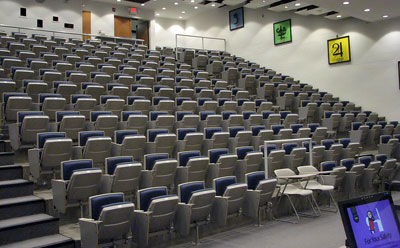 Years of work on two Faraday lecture halls was successfully completed in time for students’ return to class this fall.
Years of work on two Faraday lecture halls was successfully completed in time for students’ return to class this fall.
When the students took their seats in the large and small classrooms, they had more legroom, brighter walls and state-of-the art electronics to help them learn.
They also have new energy-saving lighting, softer seats, new carpeting and more room to take notes, said Tom Wroblewski, interim director of Architecture and Engineering Services.
“Work was done in phases,” Wroblewski said. “Last summer, the rooms were repainted and the computer equipment to make them smart classrooms was installed. This summer, the old wooden seats were taken out, the rooms were cleaned and carpeting on the stairs was installed. If there were 10 seats in a row, only eight new ones were installed.”
 The larger lecture hall has 238 seats and the smaller room has 112 seats. Both are used extensively to teach chemistry, physics and an array of other courses, said Jeff Reynolds, assistant to the dean of College of Liberal Arts and Sciences.
The larger lecture hall has 238 seats and the smaller room has 112 seats. Both are used extensively to teach chemistry, physics and an array of other courses, said Jeff Reynolds, assistant to the dean of College of Liberal Arts and Sciences.
The building that houses the lecture halls was constructed in 1963, which might have been the last time they received a makeover, Wroblewski said. They were equipped with televisions, but those stopped working years ago.
Walls covered in the original faded yellow paint were covered with a brighter beige. And shadows cast by 1960-era light bulbs were eliminated with 21st century illumination; lights were installed during winter break.
“We all owe a great deal of gratitude to Tom Wroblewski, Ben Ritter and Ken George of NIU’s Architecture and Engineering Services for the transformation of several Faraday lecture rooms in time for the start of the fall semester,” said Eddie R. Williams, executive vice president and chief of operations for NIU’s Division of Finance and Facilities.
“The results are truly astonishing” Williams added. “With the renovations, the classrooms were not only updated with new seating and lighting, but we also upgraded to ‘smart’ classrooms with all the requisite technological bells and whistles. Thanks to all for a fine job done and a special thank you to Frederick Schwantes for facilitating the project and making sure the rooms were both faculty- and student-friendly.”
by Gerard Dziuba
